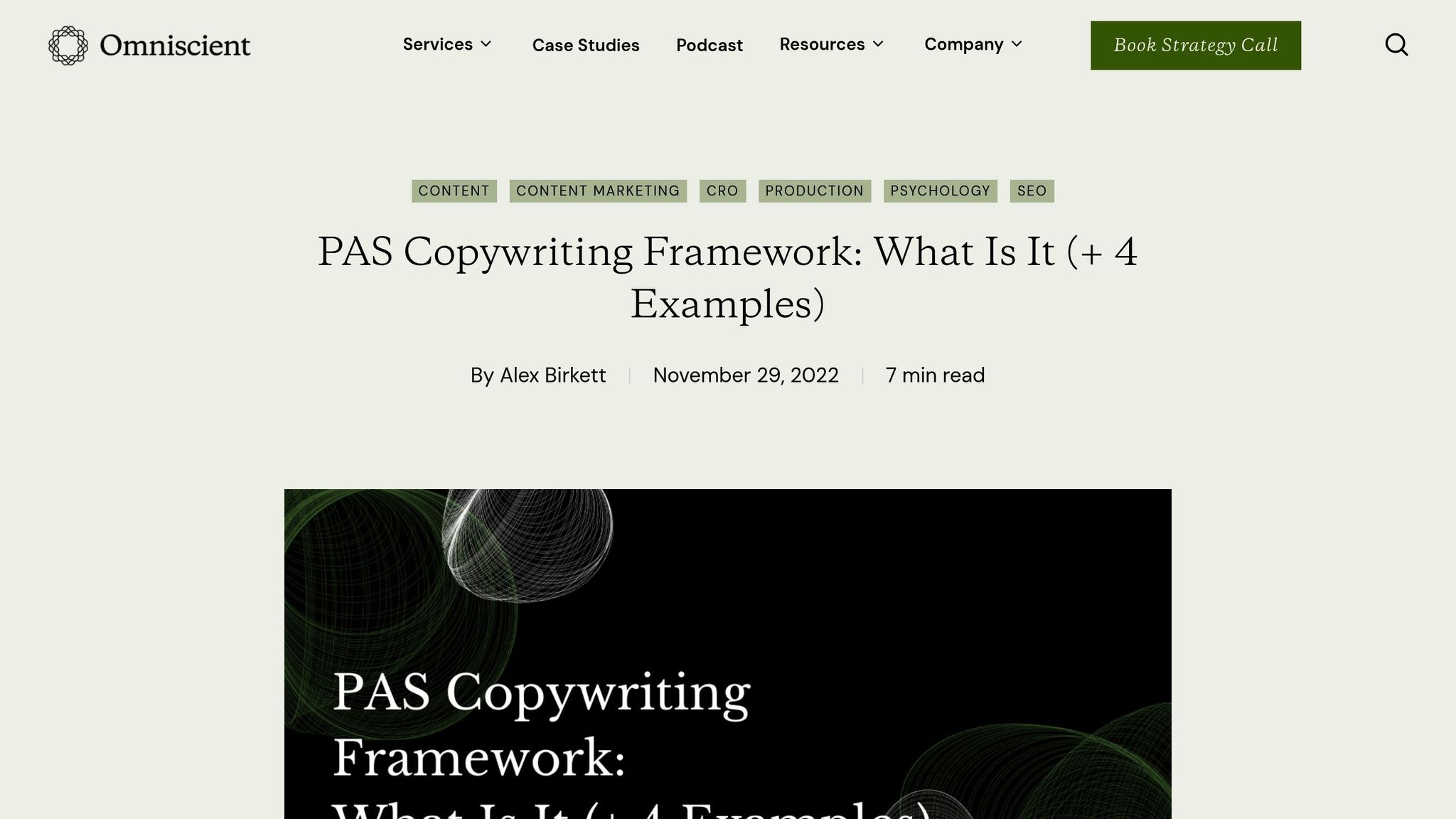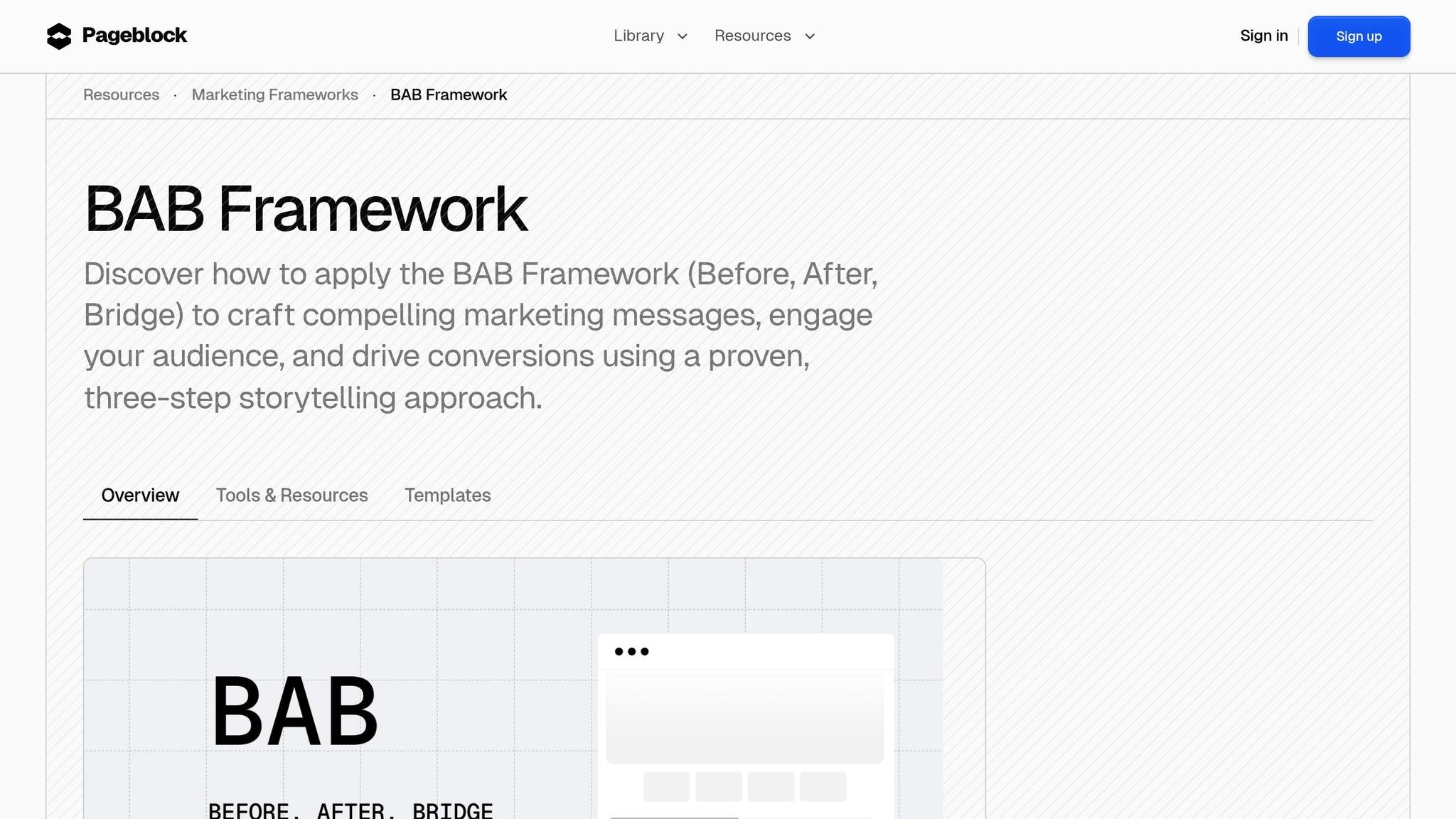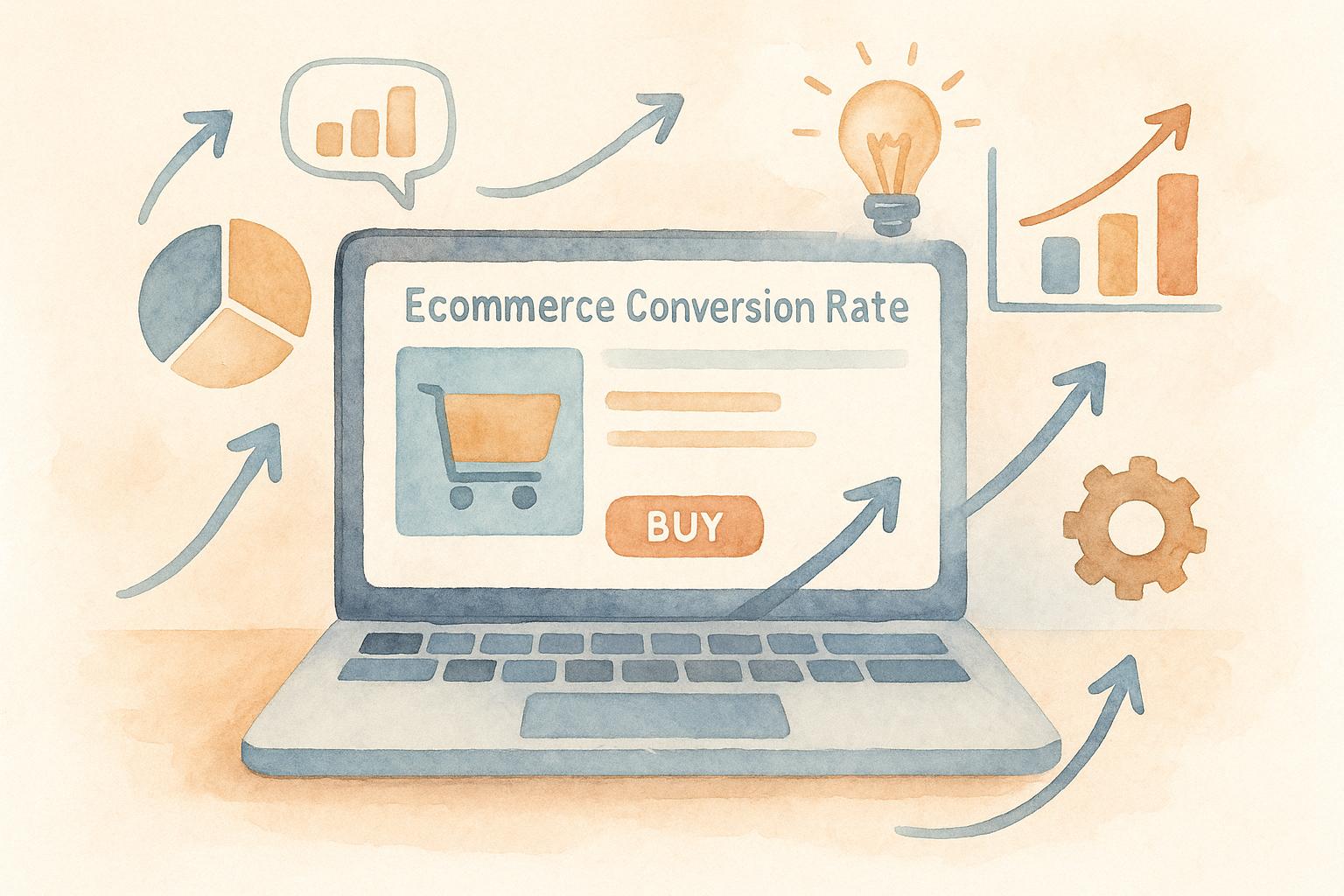Want to create landing pages that sell? Proven copy frameworks like PAS (Problem-Agitate-Solution) and AIDA (Attention-Interest-Desire-Action) are essential for direct-to-consumer (DTC) brands. These frameworks guide your audience from curiosity to purchase by addressing pain points, building trust, and leading them to act.
Here’s what you’ll learn:
PAS Framework: Focuses on solving urgent problems with emotional depth.
AIDA Framework: Guides users step-by-step from attention to action.
Other Frameworks: Includes 4 Ps, BAB, ACCA, and Story Solution for tailored approaches.
Why Frameworks Work: They simplify decision-making, boost trust, and improve conversions.
DTC brands face challenges like high customer acquisition costs and unfamiliar products. These frameworks solve those problems by creating clear, persuasive, and structured narratives. Whether you’re selling skincare or tech gadgets, choosing the right framework is key to turning visitors into customers.
Landing Page Copywriting Template: Craft Copy That Converts
PAS Framework: Problem-Agitate-Solution

The PAS framework is one of the go-to strategies for DTC copywriters. Why? Because it mirrors how people naturally solve problems: they notice an issue, feel frustrated by it, and then look for a solution. PAS taps into this process by addressing your customer's pain points and building an emotional connection before presenting your product as the answer.
For DTC brands, this approach isn't just clever - it's effective. It makes your audience feel understood and positions your product as the relief they've been searching for.
How the PAS Framework Works
PAS is built around a straightforward three-step process that moves your audience from awareness to action.
Problem: Start by naming the specific issue your target customer is facing. Be precise - focus on the one pain point that matters most. For example, if you're marketing a skincare product, you might say: "You've tried endless creams and cleansers, but your skin still breaks out before every big event."
Agitate: Next, deepen the problem by highlighting its impact. You don't just want your audience to recognize the issue - you want them to feel why it needs addressing now. For instance: "Each breakout chips away at your confidence. You avoid photos, cancel plans, and wonder if people are focusing on your skin instead of your words."
Solution: Finally, introduce your product as the hero. Show exactly how it resolves the problem you just described. Don't just list features - connect them to the pain point. For example: "Our dermatologist-approved formula clears breakouts in just 24 hours and prevents new ones, so you can step out with confidence every day."
The magic of PAS lies in specificity. If your description of the problem is vague, your solution will feel equally unconvincing. The more clearly you define your customer’s struggle, the more impactful your solution will be.
PAS Implementation Tips for DTC Landing Pages
To make PAS work on your landing page, you need to nail both the language and structure. Here’s how to do it:
In the problem section, make it feel like you’re reading your customer’s mind. Use their exact words. For example, if you’re selling meal kits, don’t say, “struggles with meal planning.” Say, “staring at your fridge at 6 PM with no idea what to cook.”
When you agitate, lean on emotions. Facts alone won’t do the job - show how the problem impacts their life. Instead of saying, “Meal planning takes time,” try, “You’re wasting your precious weekend hours in grocery store lines instead of relaxing with your family.”
In the solution section, tie every feature of your product back to the original problem. If you’ve highlighted time-saving as an issue, don’t just say your product is “convenient.” Be specific: “Pre-measured ingredients and 15-minute recipes delivered to your door mean no more grocery store trips.”
Use social proof to reinforce your solution. After presenting your product as the answer, back it up with testimonials or reviews that address the same problem. For instance: “I used to spend hours meal prepping, but now I have dinner ready in 15 minutes - this kit changed my life!”
Keep your language customer-focused. Speak directly to them using “you” instead of “we.” Instead of saying, “Our product hydrates dry skin,” say, “Your skin will feel soft, smooth, and hydrated all day.”
Pay attention to timing. Don’t rush through the problem and agitate steps - they’re crucial for building connection. But don’t drag them out so much that your audience gets bored. A good balance? Spend about 40% of your copy on the problem and agitation, and 60% on the solution and supporting details.
AIDA Framework: Attention-Interest-Desire-Action
AIDA is a step-by-step approach that mirrors how people naturally make purchasing decisions. It stands for Attention, Interest, Desire, and Action - four stages designed to guide your audience from their first impression to completing a purchase.
What makes AIDA so effective for DTC landing pages is its clear progression. It walks visitors through a journey - from noticing a bold headline to confidently clicking a button. Landing pages that follow a structured framework like AIDA can see conversion rates jump by as much as 86% compared to those without a clear strategy.
But here’s the catch: skipping a step can disrupt this flow and cause potential customers to drop off.
Using AIDA on DTC Landing Pages
Each AIDA stage has a distinct role, and nailing them can mean the difference between a quick bounce and a completed sale.
Attention is where it all begins. You’ve got seconds to grab someone’s interest, so your headline needs to deliver immediate value. For example, instead of saying something generic like "Premium Skincare Products", go with "Transform Your Skin in 7 Days." This kind of headline not only grabs attention but also promises a clear benefit. Pair it with visuals that reinforce your message for maximum impact.
Interest is where you build on the promise made in your headline. Keep your product descriptions short and to the point, highlighting key features in bullet points. Add social proof - testimonials, reviews, or even mentions in the media - to boost credibility. This combination reassures visitors that your product delivers on its claims.
Desire is all about creating an emotional connection. Show potential customers what they stand to gain by using your product. Use persuasive language, before-and-after images, and success stories to bring your product’s benefits to life. You can also add urgency with phrases like "Limited stock available" or exclusivity with lines like "Only sold here" to encourage immediate action.
Action is where everything comes together. Your call-to-action (CTA) should be bold, clear, and actionable. Use phrases like "Buy Now", "Get Started", or "Claim Your Offer" to tell visitors exactly what to do. Make sure your CTA is visually prominent, ideally above the fold, and repeat it strategically throughout the page.
Research backs this up: 70% of high-converting DTC landing pages feature a strong headline and a single, focused CTA. These elements are crucial to mastering the Attention and Action stages.
Common AIDA Mistakes to Avoid
Even with a solid grasp of AIDA, it’s easy to make errors that hurt conversions. One of the biggest pitfalls is information overload. Many brands try to cram every feature, benefit, and testimonial onto their landing page, thinking more information equals more sales. But this often overwhelms visitors and muddles your core message.
Instead, focus on one key takeaway per stage. For example, your headline should highlight one clear promise, your interest section should emphasize one standout feature, and your desire section should focus on one emotional benefit. Supporting details are fine, but they should enhance - not compete with - your main message.
Another common misstep is having weak or vague CTAs. Phrases like "Learn More" or "Submit" don’t convey urgency or value. Instead, tie your CTA to the benefit you’re offering. For instance, if your product saves time, use "Save Time Now" instead of a generic "Buy Now."
Inconsistent messaging between stages can also derail conversions. If your headline promises "instant results" but your product details mention "gradual improvements", you’ll confuse your audience. Make sure each stage builds on the last, creating a seamless and cohesive narrative.
Finally, don’t overlook the importance of visual hierarchy. Your page layout should naturally guide visitors from attention to action. Use contrasting colors, strategic white space, and varying text sizes to create a logical flow. If the visual path feels cluttered or unclear, visitors may lose focus and leave.
One last mistake? Rushing through the process. While brevity is important, each stage needs enough space to do its job. Skipping from attention to action without building sufficient interest and desire can leave visitors feeling unprepared to commit. Strike a balance: be concise but thorough, keeping momentum toward your CTA.
With these principles in mind, the next section will explore four cutting-edge copy frameworks set to dominate in 2025.
4 More Copy Frameworks for 2025
Expanding beyond PAS and AIDA, four additional frameworks are gaining traction for brands aiming to stand out. These approaches offer fresh ways to engage customers and cater to a variety of needs.
4 Ps, BAB, ACCA, and Story Solution Frameworks

The 4 Ps framework - Picture, Promise, Prove, Push - is especially effective for products where visual transformation is key. It starts by illustrating the customer's current situation, then makes a clear promise about the change the product delivers. This is followed by proof, often in the form of testimonials or data, and ends with a strong call to action. Beauty and fitness brands frequently use this framework, leveraging before-and-after imagery to drive engagement.
BAB (Before, After, Bridge) relies on storytelling to simplify complex problems. It begins by describing the customer's current state, paints a vision of a better future, and positions the product as the bridge between the two. This framework works well for products where the transformation is less immediate but emotionally impactful, such as coaching or wellness services.
ACCA (Awareness, Comprehension, Conviction, Action) is ideal for products that require more education. It builds awareness, ensures customers understand the solution, fosters conviction, and gradually leads them to take action. This method is a great fit for tech products, B2B tools, and innovative consumer goods that need more explanation to gain trust.
The Story Solution framework taps into narrative psychology to forge a strong emotional bond with customers. It mirrors a classic story arc: introducing a relatable character (the customer), outlining their challenge, detailing their journey toward a solution, and showcasing how the product delivers the resolution. This approach works particularly well for lifestyle brands and personal development products where emotional resonance is crucial.
These frameworks are particularly relevant for 2025 because they adapt to varying levels of customer awareness and decision-making styles. Unlike AIDA, which assumes a linear customer journey, these alternatives align more closely with how customers actually make decisions today.
Copy Framework Comparison Table
Framework | Primary Strength | Best Use Case | Implementation Complexity |
|---|---|---|---|
PAS | Quick problem identification | Urgent pain points, impulse buys | Low |
AIDA | Structured customer journey | General products, broad audiences | Low |
4 Ps | Focus on visual transformation | Beauty, fitness, lifestyle products | Medium |
BAB | Storytelling for engagement | Emotional purchases, complex problems | Medium |
ACCA | Educational and gradual approach | Tech products, new categories | High |
Story Solution | Emotional storytelling | Lifestyle brands, personal growth | High |
Choosing the right framework depends on understanding your customer's mindset when they land on your page. If your audience is ready to act and already aware of their problem, PAS or AIDA might work best. On the other hand, if they need more education, emotional engagement, or visual proof of results, frameworks like 4 Ps, BAB, ACCA, or Story Solution are better suited.
Consider factors like product complexity, customer awareness, and the emotional significance of the purchase. For example, a $15 skincare item might thrive with the 4 Ps framework, while a $500 course on productivity could benefit more from BAB or Story Solution. In 2025, the most successful DTC brands will tailor their framework choices to their unique customer journeys, moving beyond traditional models. Up next: discover key copywriting strategies to further optimize your DTC landing pages.
DTC Landing Page Copy Best Practices for 2025
Choosing the right framework is just the start - how you bring it to life is what makes all the difference. While frameworks lay the groundwork, applying smart copywriting principles ensures your landing page connects with today’s consumers and drives conversions.
Focus on Clarity, Benefits, and Credibility
Start with headlines that are crystal clear and communicate your product’s primary benefit in just three seconds. Skip the fancy wordplay or insider jargon - what matters most is showing how your product can make a difference in your customer’s life.
Instead of rattling off features, zero in on benefits. Think about how each feature improves your customer’s experience. For example, rather than saying "Advanced moisture-wicking fabric", go with "Keeps you dry through even your toughest workouts." This approach speaks directly to the outcome your customer is looking for.
Trust is everything. Use social proof and credibility markers to reassure potential buyers. Include testimonials with real names and locations, highlight security badges, and showcase any awards or certifications. Testimonials that include specific results, like "Lost 15 pounds in 8 weeks", are far more persuasive than vague praise. Strategically place these trust signals throughout the page - not just at the bottom.
Finally, create genuine urgency. Highlight real inventory levels or limited-time offers to encourage action. For example, specifying “Only 5 left in stock” or “Offer ends in 24 hours” can nudge hesitant buyers into making a decision.
Once your copy is live, it’s all about testing and refining.
Testing and Improving Your Copy
A/B testing is your best friend. Test one element at a time - like headlines, calls-to-action, or value propositions - to see what clicks with your audience. Allow your tests to run through a full business cycle to account for weekly behavior patterns.
But don’t just focus on conversion rates. Look at other engagement metrics like time on page, scroll depth, and click-through rates on specific sections. Heat maps can reveal which parts of your page grab attention and which are being skipped, giving you a clear roadmap for improvement.
Customer feedback is another goldmine. Ask recent buyers what convinced them to purchase, what concerns they had, and what they felt was missing. Incorporate their exact words into your copy - often, customers describe benefits in ways that resonate better than polished marketing language.
Keep your copy fresh by scheduling regular updates. Rotate in new testimonials, adjust offers, and integrate new insights from customer feedback. Small, consistent tweaks can lead to big results over time.
At the heart of these efforts is a deep understanding of your market.
Using Market-Driven Insights
To create copy that truly connects, you need to know your audience inside and out. Go beyond basic demographics and dig into their motivations, pain points, and the language they use to describe their problems. Whether your customers prioritize convenience, health, cost savings, or status, let those priorities guide your messaging.
Tailor your copy to different traffic sources and customer segments. For example, someone arriving from a Google search might need a different approach than someone clicking through from a social media ad. Adjust your messaging to match their mindset and where they are in your sales funnel.
Stay ahead of the curve by regularly analyzing customer conversations, reviews, and market trends. This helps you uncover new pain points and benefits to highlight. Competitive research is also key - look at what your competitors are emphasizing and identify where your product stands out. Then, back up your claims with evidence or customer testimonials to make your differentiation undeniable.
The brands that dominate in 2025 will be the ones that pair proven frameworks with these copywriting essentials. By focusing on clear, benefit-driven messaging and staying in tune with your audience, you’ll not only convert visitors but also build lasting customer relationships. Bold, honest, and customer-focused copy is the way forward.
How to Choose the Right Framework
Deciding on the best framework for your needs means considering your product, audience, and business goals. Each framework has its strengths, and the key is to align those with what you're offering and who you're targeting.
For example, PAS (Problem-Agitation-Solution) is ideal when your customers face a pressing and emotionally charged problem. It works best for products that solve clear, urgent issues. If the pain point is obvious and resonates deeply, PAS can deliver a powerful impact.
On the other hand, AIDA (Attention-Interest-Desire-Action) shines when you're introducing newer or less familiar products. It's perfect for situations where your audience might not even realize they have a problem yet. Products like tech gadgets, subscription services, or lifestyle items often benefit from AIDA’s ability to build awareness, educate, and spark desire.
If you're working with an established brand, storytelling frameworks like Story Solution can help forge deeper emotional connections with your audience. Meanwhile, newer direct-to-consumer (DTC) brands might find success with BAB (Before-After-Bridge), which focuses on showcasing a clear transformation without requiring a lot of pre-existing trust.
Your traffic source also plays a role. Visitors from Google ads, who are often already aware of their problem, tend to respond well to PAS. In contrast, visitors from social media, who might need more education or inspiration, are usually more receptive to AIDA.
For maximum impact, consider layering multiple frameworks throughout your content. For instance, you could use AIDA in your hero section to grab attention and build interest, follow with PAS mid-page to address specific pain points, and close with social proof and urgency to drive action. Many successful DTC brands use this layered approach to guide customers through different stages of the buying journey.
Understanding your customers' buying stage and motivations is crucial. Try testing different frameworks with small audience segments before committing to a full redesign. Your conversion data will reveal which approach resonates best with your market.
FAQs
How can I choose the right copywriting framework for my DTC landing page?
To pick the right copywriting framework for your DTC landing page, you need to start by clarifying the page’s main objective and getting a solid understanding of your audience. For instance, the AIDA framework - Attention, Interest, Desire, Action - is great for grabbing attention and leading visitors through a persuasive path, making it a strong choice for boosting conversions. Meanwhile, the PAS framework - Problem, Agitate, Solution - is particularly effective for highlighting customer pain points and positioning your product as the answer. This approach works especially well for products that solve specific problems or focus on wellness.
Think about your brand’s unique value and how your audience interacts with your messaging. It’s also smart to test different frameworks on your landing pages to see which one clicks best with your visitors and delivers the strongest results.
Can I use more than one copywriting framework on a landing page, and how should I do it effectively?
Yes, it’s absolutely possible to use multiple copywriting frameworks on a single landing page to make it more engaging and persuasive. The trick is to structure them in a way that feels natural and seamless. For instance, you could start with AIDA (Attention-Interest-Desire-Action) to capture attention with a compelling headline and spark curiosity, then transition to PAS (Problem-Agitate-Solution) to dive into your audience’s challenges and present your solution.
The most important part? Making sure these frameworks work together without overwhelming your visitors. Begin with elements that grab attention, clearly outline the problem, and guide them step by step toward your call-to-action. A smooth, logical flow keeps things clear and boosts the chances of converting visitors into customers.
What are the biggest mistakes to avoid when using the AIDA framework on a DTC landing page?
Common Mistakes to Avoid with the AIDA Framework on DTC Landing Pages
When applying the AIDA framework to your direct-to-consumer (DTC) landing page, there are a few pitfalls that can derail your efforts:
Weak headlines: Your headline is the first thing visitors see. If it doesn't grab their attention with clarity and appeal, they might leave before exploring further.
Unclear value proposition: If your product's benefits aren't obvious, it's tough to spark interest or create a sense of desire. Make sure your value is front and center.
Ineffective calls-to-action (CTAs): A CTA that's vague or uninspiring won’t motivate visitors to take action. Your CTA should be clear, compelling, and impossible to ignore.
On top of these, steer clear of distractions like excessive links, intrusive pop-ups, or cluttered designs. These can pull attention away from your primary goal. A clean, focused, and user-friendly page is essential for improving conversions.



